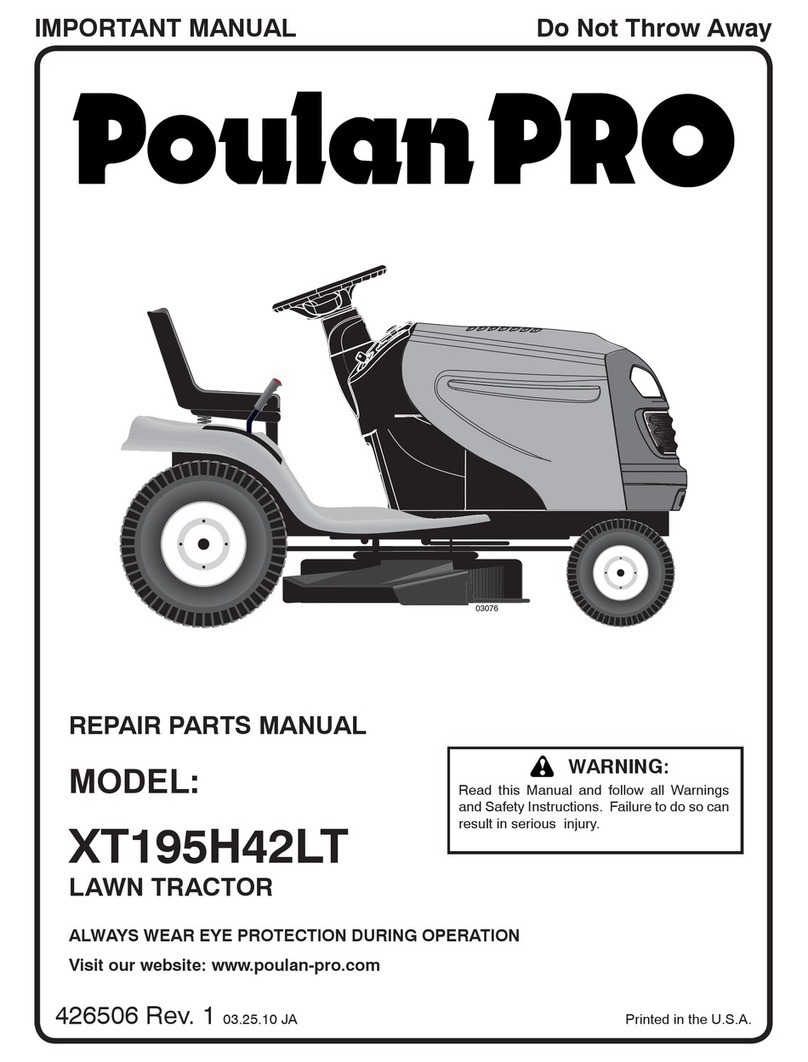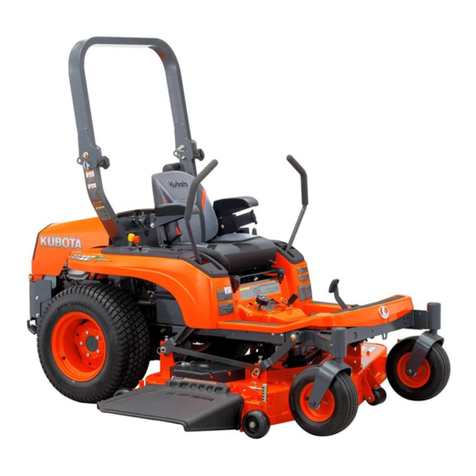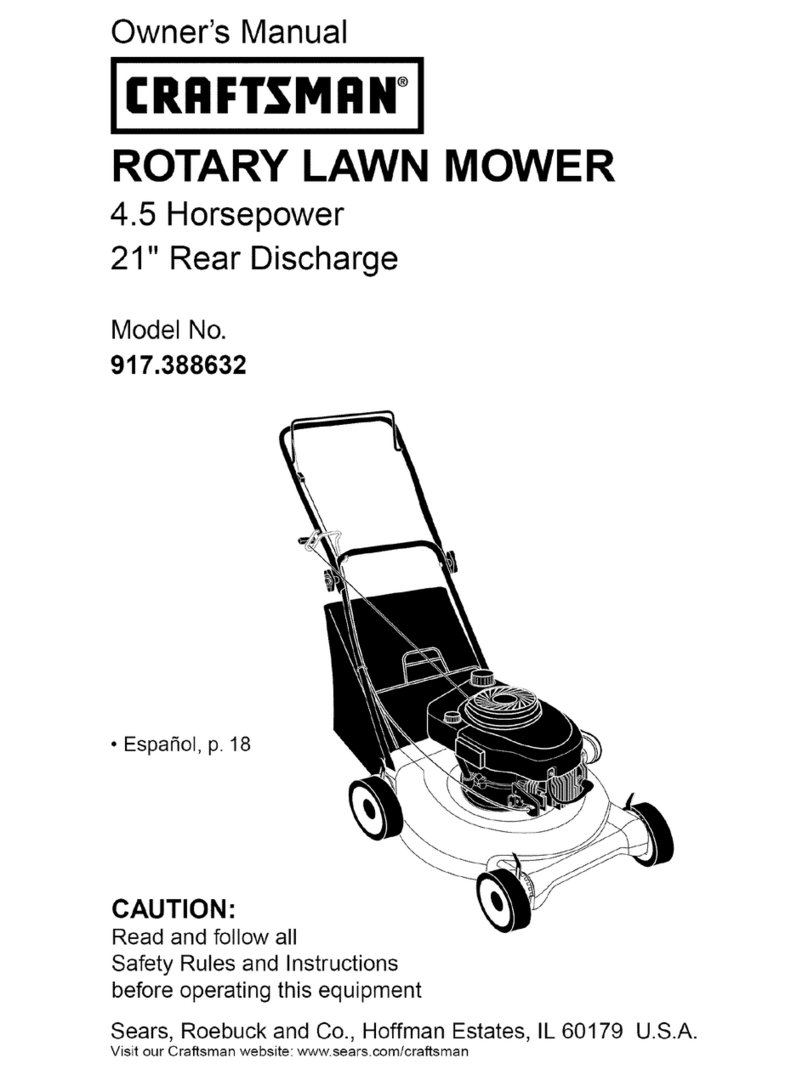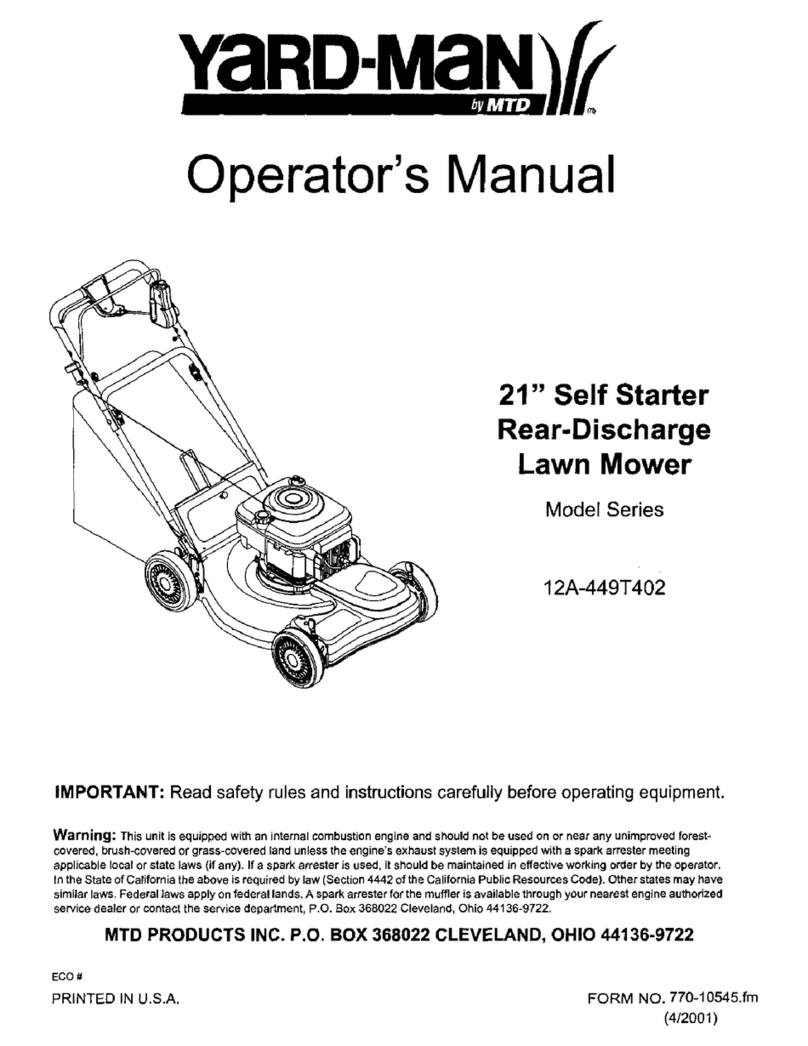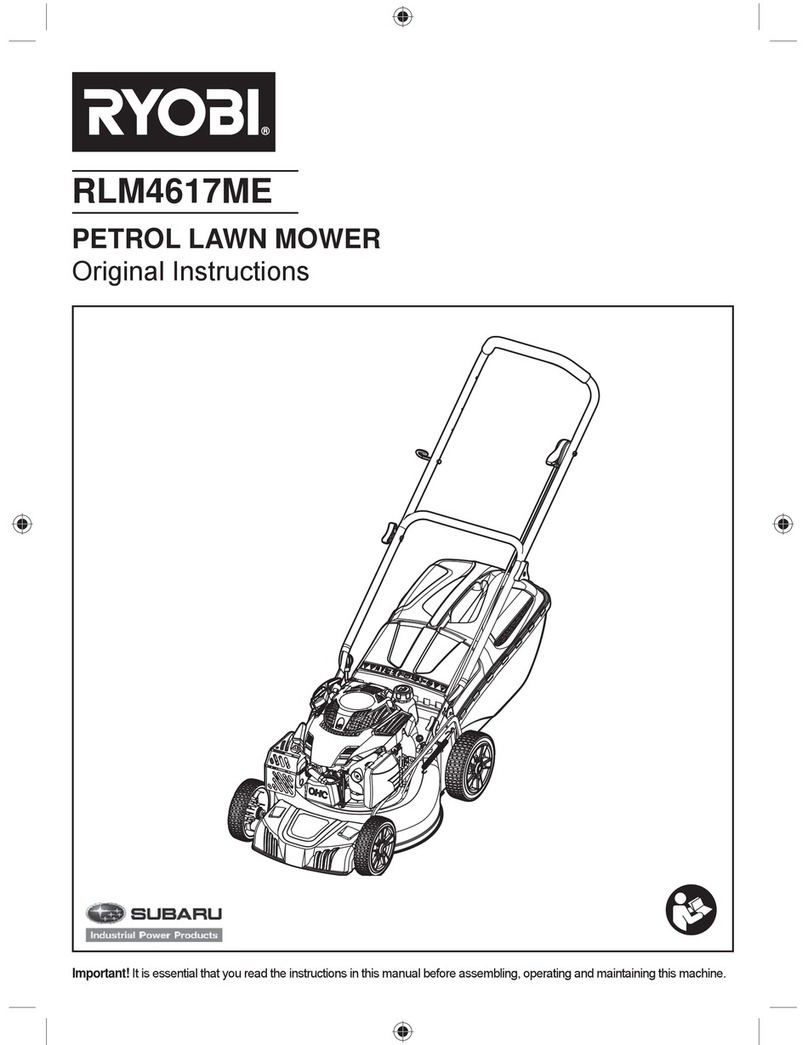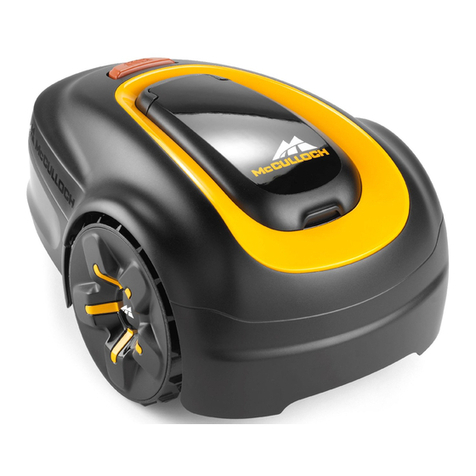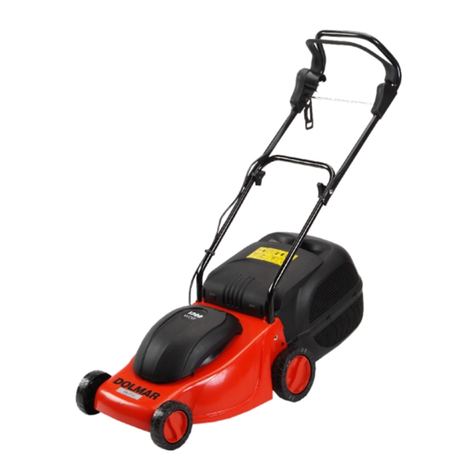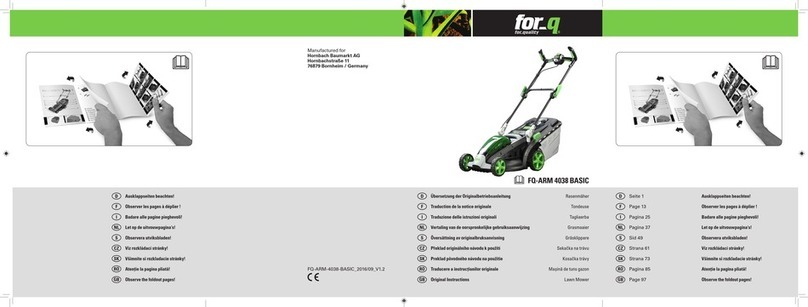TARAL VST 818 Operator's manual

T
ARAL
- VST 818
TRACT
OR
USER
INSTRUCTION MANUAL
T
aral Tarım Makina ve
Aletleri Sanayi
A.Ş.
Maltepe Mah. Hastane Yolu Sok. No:1 P
.K. 34010 Zeytinburnu/İST
ANBUL
Tel: +90 212 5679550 (Pbx) Fax: +90 212 6740679 / +90 212 6121239
e-mail: info@taral.com website: http://www.taral.com
Form No: KBK-7205207 Revision No: 0 Publish Date: 01.08.2012


INTRODUCTION
We would like to thank you, our valuable customers, for purchasing this TARAL product.
This instructionmanual contains information on the operation, lubrication and maintenance of your tractor. The informationcontained is
comprehensive and essential, and is designed to assist you, even-if inexperienced, in utilizing your Tractor.
If the tractor is sold or transferred to another person, give this manual to any new owners or operators of the tractor as they may
need the information contained. If you lose this manual, request a new one from the dealer.
How well your Tractor continues to give satisfactory performance depends greatly upon the manner in which it is operated. It is, there-
fore, requested that this manual be read carefully and kept ready for use so that the operation and maintenance services will prop-
erly be carried out in order to keep the tractor in top mechanical condition at all times.
Should any information as to your tractor be required, consult your local dealer or distributor stating the product model and its chassis
and engine serial numbers of the Tractor concerned.
We are sure you will be happy with your Tractor.
NOTE:
The drawings used in this catalogue are for demonstration purposes only and may slightly be different from your tractor.
NOTE:
Keep this tractor instruction manual in a safe and convenient place to avoid any damages or wearing. Read this manual carefully
when you require any information or have concerns about operation and maintenance of your tractor.
NOTE:
Expressions such as LEFT, RIGHT, FRONT or REAR used in this manual should be understood in accordance with following rules:
FRONT means the front grill end while REAR means the lifting arm end of the Tractor. LEFT or RIGHT means the left or right hand
side of the Tractor looking forward from operator's seat.
Right
Front
Rear
Left

TRACT
OR TYPE INFORMATION
Tractor Brand:
TARAL
Tractor Type:
818D
Tractor Variant:
818D 4WD AR
Tractor Category:
T2
Tractor Trade Name:
TARAL - VST 818
Manufacturer of Tractor:
TARAL
T
arım Makine ve
Aletleri Sanayi A.Ş
.
Address:
Maltepe Mah. Hastane Yolu
Sok. No:1, 34010, Zeytinburnu,
İstanbul
Telephone:
+90 212 5679550
Fax:
+90 212 6740679
+90 212 6121239
e-mail:
info@taral.com
web site:
www.taral.com
TRACT
OR IDENTIFICA
TION PLA
TE
It is located at the left side of the tractor tunnel sheet.
SERIAL
NUMBER
Chassis serial number
It is located at the right side of the transmission case
specifically upper side.
Engine serial number
It is located at the right side of the cylinder block,
specifically injection pump side.
NOTES, CAUTIONS and WARNINGS
NOTES, CAUTIONS and WARNINGS are used in this manual to emphasize important and critical instructions. They are
used for the following conditions:
NOTE............. An operating procedure, condition, etc., which is essential to highlight.
CAUTION................
WARNING...............
Operating procedures, practices, etc., which if not strictly observed, will result in damage or
destruction of machine.
Operating procedures, practices, etc., which if not correctly followed, will result in personal
injury or loss of life.

T
AKING DELIVERY
OF THE TRACTOR
When your tractor is delivered, ask your dealer to perform the
first operation and provide you information on instruction and ma-
intenance. If you have further questions, please contact the fac-
tory.
Make sure all components are installed and in perfect working
condition before taking the delivery of the tractor. Make sure all
accessories are provided, the tool box including all tools is ava-
ilable and no manual is missing.
Documentation of the tractor:
User Instruction Manual
Log Book
Warranty Card
Service Center List
THE LIFE OF THE TRACTOR
Tractor is designed to operate for 10 years. The life of your trac-
tor may be realized or even extended by observing the rules and
methods described in this manual, performing scheduled mainte-
nance before and after warranty period at authorized maintenan- ce
centers and using original TARAL spare parts.
WARRANTY
All products manufactured by TARAL and purchased from autho-
rized dealers and services are under warranty.
We recommend you to use original TARALparts supplied by aut-
horized dealers or services.
Damages resulting from faulty operation, insufficient or late ma-
intenance, use of non-original spare parts or implements not al-
lowed and are not covered under warranty.
NOTE:
The tractor may be operated with several implements; however,
this manual may not give information about each possible imple-
ment to be used. Consult your dealer or the factory about the
conformity of such implements which are not described in this
manual, before using them.
TARAL may not be held liable for the damages or unexpected
losses that may result from the incorrect installation, handling of
undescribed or unapproved implements and/or incorrect operation
of the tractor.
SAFETY
One of the main concerns focused during the development and
production of the tractor is operator’s safety. Design is composed of
several safety issues.
Despite all these precautions, accidents may still occur and most of
them are caused due to the safety precautions neglected. The best
way to prevent accidents is to be aware of the possible risks and
precautions to be taken and behave accordingly.
Prior to the operation of the tractor, operator must be aware and
have a thorough understanding of the safety warnings and pre-
cautions described in this manual. All protective elements must be
in place and undamaged, and if damaged they must be serviced
immediately. Tractor must not be operated without the operator is
seated. Ensure that all warning labels is in place and legible, and if
not, replace the labels.
Operator of the tractor must always be well-rested and alert and
must not be under the influence of alcohol or drug. Persons who
use prescribed medicines may not use a tractor without the per-
mission or report by a doctor.
PRECAUTIONS
ON OPERATION
OF
THE
TRACTOR ON ROAD
Prior to the operation of the tractor, be sure that all functions
described in this manual perform properly.
In case you notice a loose bolt or any damage on some of the
equipments or parts, stop the tractor immediately and do not turn
back to working until the failure/problem is solved.
Operator must know local traffic rules and laws and has a valid
driving license for driving on road.
Ensure that the plate is placed so that it is visible during travel-
ling and all documents that may be necessary are around.
Do not allow children to use the tractor or hitch any implement to
the tractor.
Be sure that PTO is deactivated, brakes are linked and the dif-
ferential lock is released.
Keep rotary warning light on when travelling on road, this will
help other vehicles that are distant, behind a hill or out of the field
of clear view to notice you easily.
Safety frame must always be rolled out (unfolded) and in undam-
aged condition. Do not perform any modifications on the safety
frame for any purposes.
Always fasten your seat belts when using the tractor.
Always operate and stop the tractor while you are seated.
When safety frame (ROPS) is open, be careful while passing
under bridges, canals, low-height structures or electric cables in
order to eliminate the risk of banging into them, if there is risk,
you can fold down the safety frame temporarily, when the
obstacle is passed return the safety frame to its initial position and
continue to travel.
Tractor is only for 1 person; do not carry any other passengers
on the fender, bonnet or other components of the tractor.
Be sure that there is not any person in the circle of the tractor
while maneuvering.
Do not perform any adjustments, mounting or demounting while
the tractor is operated.
While mounting, removing or using an implement, be sure that
there are no persons between the tractor and the implement.
Do not attempt or allow others to attempt to operate the tractor or
reach to the control levers from the area on which the implement
is mounted.
Never remove or mount the implements when the tractor is oper-
ated or the parking brake is not applied.
Do not allow any person under the implement, when the tractor
is operated and the implement is in use.
Move the implement to the carrying position on road, fix and carry
it without interrupting the driving and view of other travelling
vehicles.
Ensure that the glass of the lamps and signals are clean.
Avoid operating the tractor close to the areas where fixed obsta-
cles such as walls, fences, etc. are present as they may restrain
the maneuver capability of the tractor.
Do not use the tractor on neutral position, especially when oper-
ating on downward slope, be sure that the tractor is in gear.
If the road is wet or slippery, pay particular attention.
Lower your speed when approaching to hills.
Signal before turning.
Control the traffic on the intersections or while crossing; start
crossing if the traffic is suitable.

Do not try to pass over cars on road.
If the traffic behind becomes busy, pull over at an appropriate
place and give way to the vehicles behind.
This tractor is compatible for both RH traffic and LH traffic drive.
Check, and ask dealer if necessary to adjust, front lamps and
mirror regarding local regulations in your country.
TREATMENT OF
A
NEW TRACTOR
All components of your tractor are subject to stringent checking
during assembly in the factory. However, a new tractor should
be carefully checked over by the operator himself for the first
25—50 hours operation, heavy duty work should be avoided. If
heavy duty work is unavoidable, drive in a gear one stage lower
than you would normally use, and run the engine at lower rpm.
“IMPORT
ANT”
50 HOURS SERVICE
When the tractor is brand new, after the first 50 hours of run-
ning, the following service, maintenance and checking should
be carried out as specified below.
1. Replace engine filter and engine oil.
2. Replace transmission oil.
3. Retighten all bolts and nuts, paying special attention to
those for steering linkage and wheel.
4. Check and adjust the fan belt tension.
5. Check the wheels to see if their condition is good and tire
pressure is correct.
6. Retighten the cylinder head bolts and adjust valve clear-
ances.
7. Front axle diff. case and gear case oil replacement of 4-
wheel drive tractor.
8. Clean the air cleaner element.
9. Clean the fuel filter.
10. Check the front hub for end-play.
11. Check the battery electrolyte.
12. Clean the hydraulic oil filter.
This 50-hour Service is an essential procedure for keeping the
tractor in top condition, so it must be done properly.

CONTENTS
SECTION 1. SAFETY PRECAUTIONS
A. General Operating Safety Precaution ................................................................................ 1
B. Basic Safety Requirements for Maintenance...................................................................... 1
C. Operation of the Tractor...................................................................................................... 2
SECTION 2. EXTERNAL
VIEW
AND NOMENCLATURE OF EACH PART
......................................
6
SECTION 3. INSTRUMENTS
AND CONTROLS
................................................................................
8
Ignition Key
..............................................................................................................................
9
Glow Signal..............................................................................................................................
9
Glow Plug
................................................................................................................................
9
Tachometer
.............................................................................................................................
9
Hour Counter
...........................................................................................................................
9
Battery Charge Warning Lamp
................................................................................................
9
Oil Pressure Warning Lamp
....................................................................................................
9
Water
Temperature Gauge ....................................................................................................
9
Fuel Meter................................................................................................................................
10
Horn Switch
............................................................................................................................
10
Rotary Warning Light
..............................................................................................................
10
Combination Flash and
Turn Signal Switch
............................................................................
10
Throttle Lever
..........................................................................................................................
10
Clutch
......................................................................................................................................
10
Brake........................................................................................................................................
11
Parking Brake
..........................................................................................................................
11
Foot Speed Control Pedal
......................................................................................................
11
Power Take
Off
........................................................................................................................
11
Differential Lock
......................................................................................................................
12
8-Speed Transmission
............................................................................................................
13
4-Wheel Drive Shift Lever........................................................................................................
13
Safety Starter Switch
..............................................................................................................
13
Trailing Attachments
..............................................................................................................
14
SECTION 4. OPERATION
..................................................................................................................
15
Before Operating the
Tractor
..................................................................................................
15
Starting the Engine
..................................................................................................................
15
Starting in Cold Weather..........................................................................................................
15
After the Engine is Started
......................................................................................................
15
Driving the
Tractor
..................................................................................................................
15
Stopping the
Tractor
................................................................................................................
17
Tread Adjustment
....................................................................................................................
17
Front
..................................................................................................................................
17
Rear ..................................................................................................................................
18
Rear Wheel Installation............................................................................................................
18
Ballast Weight
..........................................................................................................................
18
Tire Pressure
..........................................................................................................................
18
Sound Levels
..........................................................................................................................
18
CONTENTS

Operator's Seat
........................................................................................................................
19
External Outlet Valve
..............................................................................................................
19
Front Axle
Steering Adjustment
..............................................................................................
19
3-Point Linkage
........................................................................................................................
19
Hydraulic System
....................................................................................................................
19
Position and Depth Control......................................................................................................
20
External Hydraulic Service
......................................................................................................
21
PTO Guard and Rear Hitch
....................................................................................................
21
SECTION 5. REGULAR MAINTENANCE GUIDE
..............................................................................
22
Service Schedule
....................................................................................................................
22
Service Schedule Chart
..........................................................................................................
22
Daily Inspection
......................................................................................................................
22
1. Service (Every 50 hours of operation)
................................................................................
22
50-Hour Service for a New
Tractor
..................................................................................
23
50-Hour Service for Other than New
Tractor
....................................................................
23
2. Service (Every 150 hours of operation)
..............................................................................
23
3. Service (Every 250 hours of operation)
..............................................................................
23
Maintenance Interval Chart......................................................................................................
24
Lubrication Table
....................................................................
................................................
25
Greasing Diagram....................................................................................................................
26
SECTION 6. PREVENTIVE SERVICE INSTRUCTION
......................................................................
28
Hood and Side Covers Opening/Closing
................................................................................
28
Checking the Radiator Coolant Level
......................................................................................
28
Coolant Replacement
..............................................................................................................
28
Precautions on Cooling System in Cold Weather
..................................................................
28
Antifreeze
................................................................................................................................
28
Fuel System
Air Bleeding
........................................................................................................
29
Fuel Filter
Air Bleeding
............................................................................................................
29
Fuel Pump
Air Bleeding
..........................................................................................................
29
Fuel Pipe
Air Bleeding
............................................................................................................
29
Fuel Filter Element Replacement
............................................................................................
30
Cleaning the Fuel
Tank
............................................................................................................
30
Checking the Engine Oil Level
................................................................................................
30
Engine Oil Replacement
..........................................................................................................
30
Engine Oil Filter Replacement
................................................................................................
31
Injection Nozzle Inspection
......................................................................................................
31
Cylinder Head Bolt
Tightening
................................................................................................
31
Valve Clearance
Adjustment
....................................................................................................
32
Valve Clearance
Adjustment Procedure
..................................................................................
32

Air Cleaner
..............................................................................................................................
32
Fan Belt
Tension
Adjustment
..................................................................................................
33
Battery......................................................................................................................................
33
Booster Connection
..........................................................................................................
34
Proper Procedure for Booster Connection
........................................................................
34
Proper Procedure for Removing Booster Cable
..............................................................
34
Proper Battery Service and
Tips for Safety
......................................................................
35
Checking the Electrolyte Level
..........................................................................................
36
Battery Recharging............................................................................................................
36
Transmission Oil Replacement
................................................................................................
36
Cleaning the Hydraulic Oil Filter
......................................................................................
37
Checking the 4WD Front
Axle Oil Level and its Replacement
................................................
37
Checking the Oil Level
......................................................................................................
37
Replacing the Oil of Front
Axle
........................................................................................
37
Cleaning the Radiator Screen
................................................................................................
38
Cleaning the Radiator
..............................................................................................................
38
Cleaning the Inside of Radiator
........................................................................................
38
Clutch Pedal
Adjustment..........................................................................................................
38
Brake Pedal
Adjustment
..........................................................................................................
39
Differential Lock Pedal
Adjustment
..........................................................................................
39
Throttle Lever
Adjustment
........................................................................................................
39
Hydraulic Control
Adjustment
..................................................................................................
40
Position Control
Adjustment
..............................................................................................
40
Hydraulic Pump Relief Valve
..................................................................................................
40
AC Generator (Alternator)........................................................................................................
40
Starting Motor
..........................................................................................................................
41
Glow Plug
................................................................................................................................
41
Fuse
........................................................................................................................................
41
Trailer Plug
..............................................................................................................................
41
Illumination Lamps
..................................................................................................................
41
SECTION 7. STORING
........................................................................................................................
42
Storage
....................................................................................................................................
42
Reoperation After
Storage
......................................................................................................
42
SECTION 8. WIRING DIAGRAM
........................................................................................................
43
SECTION 9. SPECIFICATIONS
AND DAT
A
....................................................................................
44
Engine
......................................................................................................................................
44
Cooling System........................................................................................................................
44
Fuel System
............................................................................................................................
44
Lubrication System
..................................................................................................................
44
Air Cleaner
..............................................................................................................................
44
Governor
..................................................................................................................................
44
Electrical System
....................................................................................................................
44
Chassis Dimensions
................................................................................................................
45

Clutch
......................................................................................................................................
45
Transmission............................................................................................................................
45
Power Take
Off
........................................................................................................................
45
Brake........................................................................................................................................
45
Steering....................................................................................................................................
45
Hydraulic System
....................................................................................................................
46
3-Point Linkage
........................................................................................................................
46
Drawbar
..................................................................................................................................
46
Maximum
Tire Load Capacity
..................................................................................................
46
Maximum Axle
Loads
..............................................................................................................
46
Travelling Speed
......................................................................................................................
47
Capacities
................................................................................................................................
47

SECTION 1 - SAFETY PRECAUTIONS
REMEMBER: "SAFETY" IS ONL
Y
A
WORD UNTIL IT IS PUT INT
O PRACTICE
Improper handling of the tractor could lead to an accident. Prior to the operation of the tractor, be sure to read this Manual
carefully and have a thorough understanding of all of the contents. In particular, the instructions given in this section enti- tled
"Safety Precautions" must be strictly followed.
A. GENERAL OPERATING SAFETY PRECAUTION
1. Observe all the safety precautions in this manual when
operating the tractor.
2. Operate the tractor with suitable clothing that allows easy
movement. Avoid loose jackets, mufflers, ties, scarves, or
loose shirt sleeves to prevent from being caught by mov-
ing parts. It is recommended to have a fire extinguisher
and a first aid kit near by. Operator must know the place
and utilization of these equipments.
2. Keep tractor steps clean to avoid accidents due to slippa-
ge. Dust, mud, snow, ice, etc. must be removed from the
pedals and brakes as they may cause slippage.
3. Cover the PTO shaft with a guard when not being used.
4. Be sure to apply the brake and lower any attachment or
implement before disassembling any part.
5. Never adjust or service the tractor when it is in motion or
while the engine is running. Always adjust the brake or
clutch properly in accordance with the adjusting procedu-
re in the instruction book.
6. Do not remove the radiator cap while the engine is run-
ning. Shut down the engine and wait until it cools suffici-
ently. For removal, turn the cap to the first stop to relieve
pressure. To replace the coolant, use the coolant reco-
very tank. Do not touch engine, muffler, exhaust pipe or
exhaust manifold while the tractor is running or just after
running, wait until these parts are cold before performing
any procedures.
3. Always work when you are in good physical condition by
taking sufficient rest to avoid overwork.
4. Do not allow children or adults having no knowledge of
the tractor or tractor operation, to operate the tractor.
5. Never allow riders on the tractor, linkage drawbar or
attachments while travelling and operating them.
B. BASIC SAFETY REQUIREMENTS FOR MAINTENANCE
Always follow these maintenance instructions before operating
the tractor:
7. Hydraulic oil or fuel escaping under pressure can pene-
trate the skin, causing serious injury. Before disconnect-
ing oil or fuel lines, be sure to relieve all pressure. Before
restoring pressure after repair, be sure all connections are
tight and all hydraulic components are in normal condi-
tion. Pressure oil may not be observed visually. You may
use a carton for detection purposes. If injured by leaking
fluid, see a doctor immediately for proper treatment.
8. When refueling, be particularly careful first to stop the
engine completely to prevent the fuel from igniting.
Never refuel in the presence of an open flame or while
smoking. Always use funnel when adding fuel and refuel
only out of doors. When refueling is completed, wipe any
spilled fuel off the tractor and securely fasten the cap of
the fuel tank.
1. Immediately repair the head lights and work lamps
required to conform to traffic regulations where the tractor
is operated.
1

9. Before starting any work on electrical equipment or work
that may cause you to touch the electrical part accidentally,
first disconnect the battery cables. Never remove the
rubber cap cover at the positive terminal of the battery
cable end. Before connecting the battery to the charger,
make sure that the charger switch is in "OFF" position. Be
sure to connect the charger to the correct terminals on the
battery, (positive to positive, negative to negative). Agreat
amount of hydrogen gas is generated by the battery when it
is being charged. Take precau-tions against fire: do not
have any exposed flame in the area where you are work-
ing. Be sure not to cause any leakage of the electrolyte,
since it will corrode the skin or clothing. In case of accidentas
described below, immediately seek first aid, and see a
doctor immediately for proper treatment.
a) If the diluted sulfuric acid from the battery has gotten
into the eyes: Cleanse the eyes with a lot of clean run-
ning water for more than 15 minutes, while opening the
eyes widely.
b) If diluted sulfuric acid from the battery has been swal-
lowed:
Rinse the mouth with clean water immediately anddrink
a lot of raw eggs or milk. Lie down quietly.
c) If diluted sulfuric acid has gotten on the skin or clothing:
Wash away the diluted sulfuric acid completely with a
lot of clean running water and neutralize with soap
solution. Then rinse with water.
d) If the diluted sulfuric acid is spilled:
Wash away with a lot of water or neutralize with
slacked lime or bicarbonate of soda.
10. If you intend to use the tractor for applying pesticide, wear
suitable protective gear such as goggles, mask gloves,
etc. Avoid direct contact with or breathing agricultural pes-
ticide as they may be dangerous for your health. For fur-
ther information, consult the manual of pesticide.
11. Stop the engine and make sure the PTO shift lever is in
Neutral before performing any of the following services,
including:
a) Removal of the propeller shaft between PTO and any
attachment,
Adjustment of PTO drive train and hitch.
c) Adjustment or cleaning of PTO driven attachment.
12. The steering wheel always has built-in play to some
extent, which is required for smooth working of sector
gear and pinion gear. Always inspect the amount of the
play. Do not operate the tractor if there is too much or too
little play in the steering.
C. OPERATION OF THE TRACTOR
Before driving the tractor, follow these rules:
C-1 Before Starting and Driving the T
ractor
Operate the tractor only when seated properly in operator's
seat and keep a firm grip on the steering wheel at all times.
Never attempt to perform any operation of the tractor from any-
where else, on or off the tractor. Always wear a "hard hat"
when operating the tractor.
Do not attempt to jump start the tractor, always start the engine
with ignition key.
C-2 Starting and Driving the T
r
actor
Always operate the tractor at the proper speed which enables
you to keep the tractor under your complete control.
2

LOW
Never attempt to jump on or off a moving tractor.
HIGH
To start travelling, lower the engine speed and release
the clutch pedal slowly. Abrupt releasing causes the
tractor to jump off.
Before leaving the tractor, stop the engine, remove the
key, apply the parking brake and make sure that the
engine has come to a complete stop, and any attach-
ment is completely touching the ground.
KEY
LOCK
When starting the tractor, operating any attachment or
engaging the PTO make sure that no one is in the way,
especially children.
When starting the engine in an enclosed area or building,
ensure proper ventilation by opening the doors and/or win-
dows to prevent carbon monoxide inhalation. Mount the
extension exhaust pipe on the tractor if has a cabin.
.
3
Slow down when operating the tractor on rough ground

If ROPS is folded, level it down, fasten the seat belt
before using the tractor and keep it fastened while in
operation.
Never operate the differential lock while driving at high
speed or travelling on the road.
For driving the 4-WD tractor on the road, be sure to
place the 4-WD shift lever in OFF position.
C-4 Steering and T
urning the T
ractor
Slow down your tractor and disengage the differential lock
before going into a turn, being careful to prevent any
attachment mounted on the front or rear from hitting
anyone or anything.
C-5 T
owing and Operating on Hills
For towing work on downward slope, place the shift
lever in low speed and use engine brake. Never try to
reduce the speed with brake only.
Towing a heavy object on a hill is highly hazardous.
Widen the tread of the tractor and mount the wheel
weight or chassis weight to increase the stability and
operate with extra caution. If necessary, connect front
wheels drawbar (4WD).
It is not recommended to use tractors without ROPS.
When operating the tractor on higher a steep slope or
flat ground, be sure not to suddenly steer, brake or
operate clutch or attachments.
C-3 T
ravelling on Roads and Streets
For travelling on roads and streets be sure to lock both
brake pedals together before driving to prevent either
brake from acting independently.
Do not operate the tractor at the edge of cliff or steep
slope. Be particularly careful right after the rain when
soil is soft and may give way easily. If necessary, con-
nect front wheels (4WD).
4

For towing, be sure to use the drawbar only. Set the
hitch point below the center line of the rear axle. When
using a chain, never try to move forward abruptly. When
using a long chain or cable to hitch the tractor to the
load, drive the tractor forward slowly until all slack is
taken out.
When towing or running on a steep downward slope, be
sure to apply the engine brake to keep safety speed.
Never run by inertia (coasting) with main shift lever
placed "NEUTRAL' position or the clutch disengaged.
C-6 Using
Attachment
To mount or operate attachments, follow the instruction
manual for the particular attachment for safe operation.
Avoid operating the tractor on an extreme slope that
appears hazardous, when forced to operate on such
slope, use extra care.
Driving forward out of a ditch or mired condition or up a
steep slope could cause tractor to tip over rear-ward.
Back out of such situation if possible. If the situation
does not permit you to back out, use the front wheel
weight or the chassis weight for balancing the tractor
lengthwise. Also in case any extra heavy rear mounting
attachment is used, try to obtain better balance in this
manner.
When backing down a slope in reverse gear or going up
the grade in forward gear, never operate the clutch,
brake, throttle lever or steering wheel abruptly. Be par-
ticularly careful on slippery roads.
In any case of towing (by use of a rope or by hanging up
the front), be sure to place the both main shift lever and
sub shift lever at "NEUTRAL' position so long as the rear
wheels are on the ground.
*These shift levers shall not be placed at any other
speed range.
When starting the engine by towing the tractor with a bat-
tery as discharged, be sure to place the main shift lever at
the 3rd speed step and the sub shift lever at the high
speed step, then operate the clutch slowly.
*Never place the sub shift lever at the low speed step.
When towing the tractor, be sure to keep the safety speed.
It is advisable to operate at 10 km/h or less in towing the
tractor under 20 HP and at 15 km/h or less in towing the
tractor over 20 HP.
When using agricultural chemicals with an attachment
on the tractor, always follow the Instructions in the man-
ual for the attachment as well as the Instructions provid-
ed by the chemical manufacturer.
C-7 Roll Over Protective Structure (ROPS)
We strongly recommend a ROPS (Roll Over Protective
Structure) install to your tractor. It must not be removed
even temporarily. It must not be folded when travelling. It
is not recommended to utilize additional elements to per-
form drilling, welding or reinforcement on the construc-
tion, this procedure will weaken the construction. If any
damage is observed on the construction, it must be
repaired at a technical service or replaced.
Exercise good care in seat belt Installation as regard belt
strength and the bucket, which must not be broken off or
disconnected.
For further details, ask your authorized technical service.
5

SECTION 2. EXTERNAL
VIEW
AND NOMENCLA
TURE OF EACH P
ART
The above photos show TARAL-VST 818.
6

123645
1. Battery
2. Radiator cap
3. Air cleaner
4. Engine oil filler cap
5. Fuel tank cap
6. Alternator
243
1.Nozzle
2. Fuel Injection
Pump
3. Air Cleaner Inlet
4. Radiator Hose
For opening the bonnet, remove backward the hook on the rear side of the bonnet.
When closing the bonnet, be sure to confirm the bonnet is secured.
7
2
1

SECTION 3. INSTRUMENTS
AND CONTROLS
51
72 36
1. Fuel Meter
2. Tachometer
3. Water Temperature
Gauge
4. Combination
Switch Indicators
5. Stop Switch
6. Head Lamp and
Horn Switch
7. Ignition Key
21
1. Throttle Lever
2. Fuse Box
8
4 5 2 7

TACHOMETER
AND WARNING LAMPS
T
achometer
Fuel Meter
W
ater Temperature
Indicator
Alternator Charging
Indicator
Glow Plug Indicator
Battery low Warning
Lamp
Oil Low Pressure W
arning
Lamp
Hour Counter
Heat position………………… Power applied to the glow plug
OFF position........................ Engine and all lights turned off
ON position.......................... Engine running and electrical
circuit energized.
START position.................... Starts the engine then
key returns to "ON" position.
The tachometer indicates engine rpm.
Indication of Meter
2340 at PTO 1st shift
1793 at PTO 3rd shift
R.T.O. shift rotation
540 rpm
1000 rpm
CAUTION
Be sure to remove key whenever tractor is not in operation.
GLOW SIGNAL
When the ignition key is turned ON, the Glow Signal lights up in
the Instrument Cluster, indicating that the engine is
preheated.
BA
TTERY CHARGE WARNING LAMP
When the ignition key is set to "ON", this lamp lights up. When
the battery is being charged normally while the engine is run-
ning the lamp should go off. If the lamp continues to light, stop
the engine immediately and see your dealer.
GLOW PLUG
The engine is fitted with speed heating sheathed glow plug
which preheat the combustion chamber so that the engine may be
started easily even in cold weather.
HOUR COUNTER
Every 1 hour of engine operation, the counter shows 1 units of
increase.
OIL
PRESSURE WARNING LAMP
When the ignition key is set to "ON", this lamp lights up. When
oil is circulating normally while the engine is running, the lamp
turns off. If the lamp still lights up after the engine has been
started, stop the engine immediately and check the engine
lubrication oil level. If oil level is insufficient, add suitable oil; If
the oil level is OK, see your dealer.
9

W
A
TER TEMPERATURE INDICATOR
When the temperature of the cooling water exceeds 110°C
(230°F).
When this occurs, lower the engine speed to about 900 rpm
immediately and wait until the warning lamp goes off. Then
stop the engine and check the amount of cooling water, the fan
belt tension, the wiring, the temperature gauge unit.
W
ARNING
Be especially careful of the removal of the radiator cap.
COMBINATION FLASH AND TURN SIGNAL SWITCH
Two flashing lights are located on the rear of the fenders.
Anytime the tractor is operated on public roads, the flashing
lights should be used. The flasher switch is installed on instru-
ment panel and it is used when making a turn to right or left.
Turning the switch leftwise causes to flash the left-hand-side
turn signal, and turning it rightwise causes to flash the right-
hand-side turn signal, respectively.
THROTTLE LEVER
FUEL METER
Indicates remaining fuel.
When the pointer comes over the "E" position, fill fuel as soonas
possible.
HORN BUTTON
Horn is effective while ignition key is in "ON" position.
Horn switch is in the combination switch provided for the head
lamp and operates when the switch is pressed down.
Throttle Lever
When the throttle lever is pushed forward, the engine speed re-
aches the maximum. The speed range controlled by lever is
900 to 2900 rpm (with no load). When the PTO gear is shifted to
"1st" at 2700 rpm (rated engine rpm), the PTO shaft rotates at
623 rpm.
Horn Button
CLUTCH
Rotary W
arning Light
1 rotary warning light is installed on the safety frame of the trac-
tor. Operates when the switch on the left fender is pressed
down.
Clutch pedal
10
Table of contents
Popular Lawn Mower manuals by other brands

Ego Power+
Ego Power+ LM2130SP-FC Operator's manual

Hyundai power products
Hyundai power products HYM40Li380P instruction manual

Sabo
Sabo JS63 VARIO Operator's manual
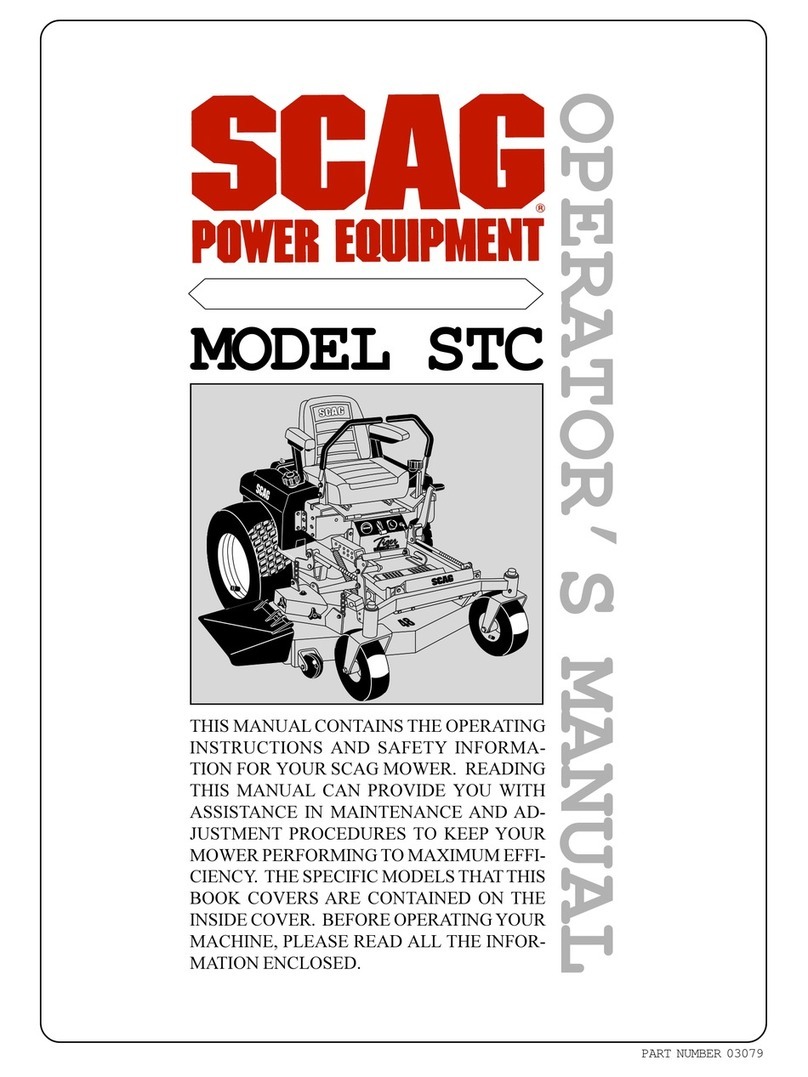
Scag Power Equipment
Scag Power Equipment STC Operator's manual
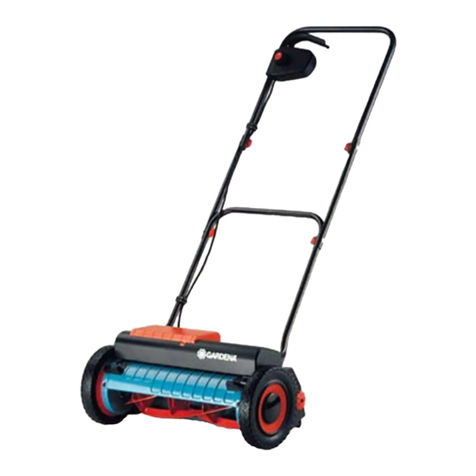
Gardena
Gardena RM 380 4040 operating instructions

Southern States
Southern States SO17542STB owner's manual
